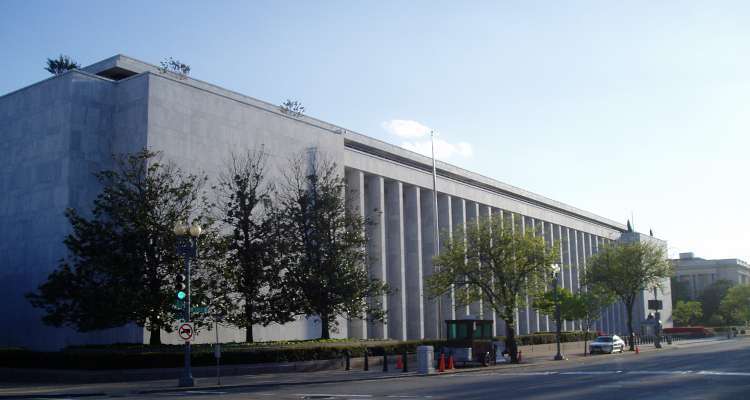
Washington, D.C.’s James Madison Memorial Building, which houses the U.S. Copyright Office.
Last week, National Music Publishers’ Association (NMPA) president and CEO David Israelite claimed that streaming services were demanding “the lowest royalty rates in history” ahead of the Copyright Royalty Board’s mechanical rate determination for 2023 to 2027. Now, DSPs have officially published their rate proposals for the half-decade stretch.
Before submissions by streaming services to the CRB were made public, Israelite stormed on Twitter to assail the DSPs’ mechanical rate proposals. The details of the streaming proposals weren’t immediately available — though Digital Music News confirmed that they’d been submitted. Either way, Israelite and the NMPA slammed the proposals as constituting the “lowest royalty rates in history,” while issuing various preemptive counterproposals. That included a variable mechanical rate that would be calculated monthly.
The NMPA-backed mechanical royalty proposal would specifically increase streaming services’ publisher payments to the highest of 20 percent of revenue, $0.0015 per play, 40 percent of the compensation forwarded to record labels/master-recording owners (the latter amount is referred to as TCC, or “total content cost”), or $1.50 per subscriber, calculated on a monthly basis, as mentioned.
And as initially highlighted, digital service providers including Spotify, Amazon Music, Pandora, Google, and Apple Music have now published their mechanical rate proposals for the 2023 to 2027 period.
These proposals came to light via “public version” documents on the Copyright Royalty Board’s website. Substantial portions of the lengthy filings – which span hundreds of pages apiece and feature all manner of “expert” opinions – have been redacted from the public variations, but the resources nevertheless include each filing party’s rate proposal.
Moreover, most of the proposals represent pre-2018 mechanical royalty rates – which, needless to say, are far beneath those suggested by the NMPA for 2023-2027. And it’s worth reiterating here that the Copyright Royalty Board’s much-opposed (by streaming services, that is) 2018-2022 mechanical rate hike brought with it all-in royalty rates of 11.4 percent, 12.3 percent, 13.3 percent, 14.2 percent, and 15.1 percent of revenue per year, respectively. Alternatively, DSPs would pay 22 percent, 23.1 percent, 24.1 percent, 25.2 percent, and 26.2 percent of TCC across 2018 and 2022, respectively, if the sum was greater, the CRB ruled.
Spotify in its mechanical rate proposal for 2023-2027 pushes for a 10.5 percent payment of streaming-service revenue for “standalone non-portable subscription offering – streaming only” – or the aforementioned pre-2018 rate. The same rate was proposed for all other categories excepting the “mixed service bundle” (11.35 percent) and locker-service payments and content (which concern ringtones, permanent song downloads, interactive streams, and more).
Spotify’s proposed TCC percentages max out at 22 percent and come in as low as 20.65 percent (for “paid locker services”), the document also shows, with Pandora (pertinent details are viewable on page 11) and Amazon Music (page two) having settled upon similar proposals. Apple Music’s own submission suggests “eliminating the total content cost prong” outright, before indicating that the all-in royalty for most categories “shall be a headline percent of revenue rate multiplied by Service Provider Revenue.”
Additionally, “Apple proposes adopting the headline rate the Judges decide in the Phonorecords III remand in this proceeding, provided the rate is reasonable under the WBWS standard” and save for the 12 percent rate on paid music lockers from Phonorecords II. The Cupertino-headquartered company likewise “proposes that, for all offerings, services pay the greater of (a) an all-in percentage of revenue less performance royalties, and (b) a per-subscriber or per-active user minimum or mechanical floor, tiered to support a variety of services and continued market segmentation.”
Of course, each of the ultra-lengthy proposals also contains unique components – with Apple, which operates Apple TV+, Apple Music, Apple News, and other subscription services yet, relaying: “If music services cannot compete in this marketplace with bundles, they may well be left behind… Apple proposes that royalties be discounted based on the proportional value of the standalone price of the components of the bundle. By way of example, if the bundle is priced to consumers at a 20% discount compared to the standalone price of the various components of the bundle, then royalties will be reduced 20% as well.”
Amazon Music, for its part, calls on the copyright royalty judges in setting the 2023-2027 mechanical rate to “adjust for the effects of the complementary-oligopoly power that publishers and record labels wield.”
More than a few professionals are weighing in on the CRB rate proceedings, with Garrett Levin, president and CEO of streaming service representative The Digital Media Association (DiMA), emphasizing in a statement streaming’s impact on “ever-growing revenues for publishers” and PROs.
“The headlines each and every day demonstrate how much streaming and streaming services continue to drive ever-growing revenues for publishers and performing rights organizations, massive investments in publishing catalogs, and innovative tools and features that connect songwriters to fans in ways never possible before,” Levin said in part.
“This CRB proceeding, like any other, does not happen in a vacuum. ‘Mechanical’ licensing is just one of the multiple, necessary licenses for streaming services within a single segment of publisher and songwriter revenue streams. And that itself is one segment of the complete digital music economy.
“The current proceeding comes at a time of sky-high valuations for all forms of music rights, more creators delivering more music to fans at the push of a button, and an increasingly vocal conversation throughout the world about the most equitable allocation of streaming royalties between recordings and songs. That is the broader lens through which this proceeding — and the interconnected nature of today’s music industry — should be considered,” finished the former National Association of Broadcasters deputy general counsel Levin.
Worth noting in conclusion is that the CRB today reopened the comment period on Phonorecords IV – that is, the 2023-2027 rates – for another 30 days. Additional comments are due no later than November 22nd.

